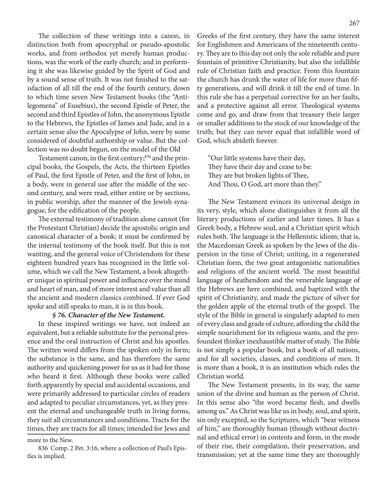267 The collection of these writings into a canon, in distinction both from apocryphal or pseudo-apostolic works, and from orthodox yet merely human productions, was the work of the early church; and in performing it she was likewise guided by the Spirit of God and by a sound sense of truth. It was not finished to the satisfaction of all till the end of the fourth century, down to which time seven New Testament books (the “Antilegomena” of Eusebius), the second Epistle of Peter, the second and third Epistles of John, the anonymous Epistle to the Hebrews, the Epistles of James and Jude, and in a certain sense also the Apocalypse of John, were by some considered of doubtful authorship or value. But the collection was no doubt begun, on the model of the Old Testament canon, in the first century;836 and the principal books, the Gospels, the Acts, the thirteen Epistles of Paul, the first Epistle of Peter, and the first of John, in a body, were in general use after the middle of the second century, and were read, either entire or by sections, in public worship, after the manner of the Jewish synagogue, for the edification of the people. The external testimony of tradition alone cannot (for the Protestant Christian) decide the apostolic origin and canonical character of a book; it must be confirmed by the internal testimony of the book itself. But this is not wanting, and the general voice of Christendom for these eighteen hundred years has recognized in the little volume, which we call the New Testament, a book altogether unique in spiritual power and influence over the mind and heart of man, and of more interest and value than all the ancient and modern classics combined. If ever God spoke and still speaks to man, it is in this book. § 76. Character of the New Testament. In these inspired writings we have, not indeed an equivalent, but a reliable substitute for the personal presence and the oral instruction of Christ and his apostles. The written word differs from the spoken only in form; the substance is the same, and has therefore the same authority and quickening power for us as it had for those who heard it first. Although these books were called forth apparently by special and accidental occasions, and were primarily addressed to particular circles of readers and adapted to peculiar circumstances, yet, as they present the eternal and unchangeable truth in living forms, they suit all circumstances and conditions. Tracts for the times, they are tracts for all times; intended for Jews and more to the New. 836 Comp. 2 Pet. 3:16, where a collection of Paul’s Epistles is implied.
Greeks of the first century, they have the same interest for Englishmen and Americans of the nineteenth century. They are to this day not only the sole reliable and pure fountain of primitive Christianity, but also the infallible rule of Christian faith and practice. From this fountain the church has drunk the water of life for more than fifty generations, and will drink it till the end of time. In this rule she has a perpetual corrective for an her faults, and a protective against all error. Theological systems come and go, and draw from that treasury their larger or smaller additions to the stock of our knowledge of the truth; but they can never equal that infallible word of God, which abideth forever. “Our little systems have their day, They have their day and cease to be: They are but broken lights of Thee, And Thou, O God, art more than they.” The New Testament evinces its universal design in its very, style, which alone distinguishes it from all the literary productions of earlier and later times. It has a Greek body, a Hebrew soul, and a Christian spirit which rules both. The language is the Hellenistic idiom; that is, the Macedonian Greek as spoken by the Jews of the dispersion in the time of Christ; uniting, in a regenerated Christian form, the two great antagonistic nationalities and religions of the ancient world. The most beautiful language of heathendom and the venerable language of the Hebrews are here combined, and baptized with the spirit of Christianity, and made the picture of silver for the golden apple of the eternal truth of the gospel. The style of the Bible in general is singularly adapted to men of every class and grade of culture, affording the child the simple nourishment for its religious wants, and the profoundest thinker inexhaustible matter of study. The Bible is not simply a popular book, but a book of all nations, and for all societies, classes, and conditions of men. It is more than a book, it is an institution which rules the Christian world. The New Testament presents, in its way, the same union of the divine and human as the person of Christ. In this sense also “the word became flesh, and dwells among us.” As Christ was like us in body, soul, and spirit, sin only excepted, so the Scriptures, which “bear witness of him,” are thoroughly human (though without doctrinal and ethical error) in contents and form, in the mode of their rise, their compilation, their preservation, and transmission; yet at the same time they are thoroughly







